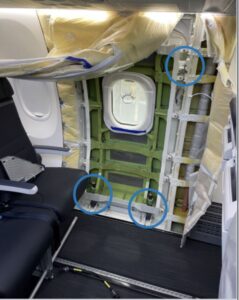

A dramatic accident on an Alaska Airlines flight last month was apparently triggered by a door plug that hadn’t been properly attached before the plane was delivered by Boeing Co., US investigators said Tuesday.
Four bolts that acted as a fail-safe mechanism to hold a panel in place weren’t installed on the Boeing 737 Max 9 jet, according to a preliminary report from the National Transportation Safety Board.
The incident has become the biggest crisis for Boeing since its entire fleet of Max jets was grounded worldwide in 2019 following two fatal crashes. Max 9 planes with the same door configuration as the Alaska jet were grounded for weeks until they could be inspected, and regulators are poring over Boeing’s manufacturing processes and ratcheting up pressure on the company’s management.

The evidence from the recovered door and the fuselage indicate that the four bolts “were missing,” the NTSB report said. The report reaches no conclusions about what caused the Jan. 5 failure, but it is an unusually detailed account of the safety board’s initial fact gathering. It contains photos of the panel that later failed that were taken on the Boeing shop floor.
The panel had been worked on during final assembly, but NTSB is still reviewing what was done and why. The safety board can take a year or longer to conclude its formal findings.
“The investigation continues to determine what manufacturing documents were used to authorize the opening and closing of the left MED plug during the rivet rework,” the report said in reference to the panel that failed.
Spirit AeroSystems Holdings Inc., Boeing’s most important supplier, has also been under scrutiny in the wake of the accident.
The incident occurred when a panel that seals an unused door opening on the left side of the Alaska Air Group Inc. jet blew open shortly after take off from Portland, causing it to violently lose pressure and subjecting passengers and flight crew to high winds and noise as it returned for an emergency landing. No serious injuries were reported.
The panel, known as a door plug, is held in place by 12 braces that withstand the massive pressure differential between the cabin and the thin air at altitude. A separate set of four bolts are designed lock it in place. The panel opens by sliding upward and the bolts, which include pins to prevent them from inadvertently loosening, prevent that movement.
Issues with Boeing’s work on the Max family of aircraft continue to emerge. On Feb. 4, the company disclosed that it had discovered manufacturing flaws with rivet holes in about 50 undelivered 737s. The problem originated with Spirit, a spokesman for that company said.
The problem disclosed Feb. 4 is the latest in a series of glitches originating with Boeing’s former aerostructures unit. A drilling mishap on an aft pressure bulkhead supplied by Spirit Aero slowed deliveries of the 737 Max last year, the planemaker’s most important generator of cash flow. A separate issue with tail-fin fittings affected output earlier in 2023.
Boeing will also have to contend with the possibility of labor disruption later this year. Boeing’s largest union, the International Association of Machinists and Aerospace Workers, will demand a 40% pay raise over three or four years, emboldened by a resurgent US labor movement, a scarcity of qualified aerospace workers and pressure on Boeing to stabilize work in its factories.
The Federal Aviation Administration is also conducting enhanced oversight of Boeing and Spirit. The agency is about halfway through its review and expects to release findings and possible recommendations as soon as this month, Jodi Baker, FAA deputy associate administrator for aviation safety, said Monday.
Top photo: An NTSB Investigator-in-Charge examines the fuselage plug area of Alaska Airlines Flight 1282 Boeing 737-9 MAX on January 7, 2024 in Portland, Oregon. Photographer: Handout/Getty Images North America.